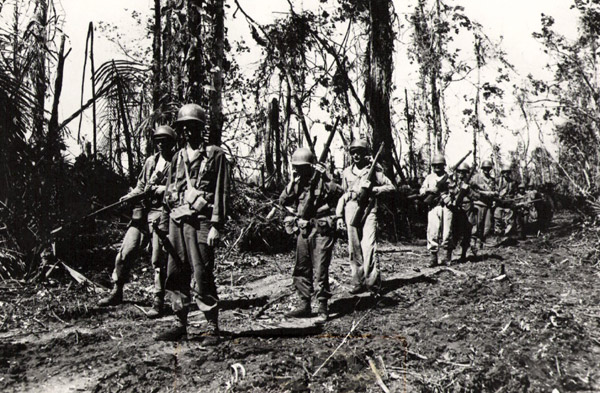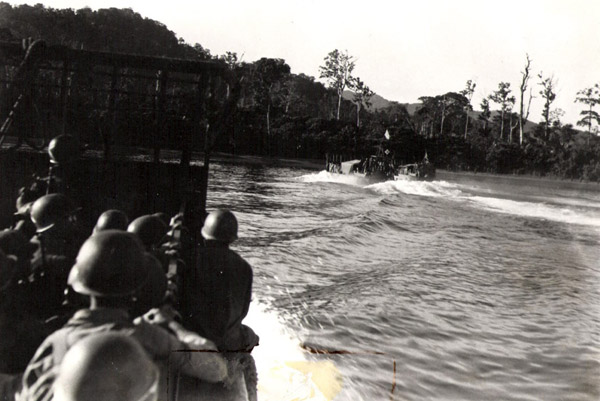The 6th Division by contrast to the Japanese were relatively green troops. This was to change in dramatic fashion. By now the Japanese forces were no longer underestimated. The entire 6th Division would be employed for battle with the two fully supported Regiments of the Japanese 36th Infantry Division. Well entrenched in and around three coral hills that were thick with Jungle, the Japanese were ready for the Americans and were protected by caves and by earthened, well-camouflaged fortifications that honeycombed the area and which were designed to effect ambush as well as protect the Maffin Airdrome. It was a trap, much in the style faced earlier at Buna New Guinea by the 32nd Infantry Division. However if the Maffin Airdrome was to be taken, the Strong Point at Lone Tree and the other hills had to be eliminated. These fortifications (Cave and Tunnel) were similar to the fortifications which would latter be faced by the 41st Infantry Division on the Island of Biak, New Guinea. The Japanese, intended to keep the Americans from the Maffin Airdrome that was still in the process of being built, to seize their weapons and food and to do everything in their power to destroy them. The battle for Lone Tree Hill was to prove to be "as severe as any fought in the Pacific."7
The Sightseers of the 20th Infantry Regiment would spearhead the assault with the 1st Infantry Regiment protecting their right flank at Rocky Point and the 63rd Infantry Regiment protecting their left flank. Before the assault took place, the hill was bombarded with artillery. Air support dropped gasoline belly tanks on the hill and strafed them to set them ablaze. A medic with the 20th Infantry, Thomas W. ("Jack") Murphy from Kentucky, watched from the beach at Lone Tree Hill and saw that the hill seemed to be honeycombed with caves.8 Unknown to Murphy and his fellow Sykesmen, the total entrenched defenders of Lone Tree Hill amounted to about 850 troops with seven 75mm Mountain Guns which were supported by another 1,000 troops in the immediate area and another 2,000 just west of Lone Tree Hill. Lone Tree Hill was one of the first encounters by United States forces with Japanese Cave and Tunnel Warfare.9
Murphy accompanied the initial patrol into the area to determine the best route of attack. A shot rang out and a soldier crumpled to the ground. Latter he watched, horrified, as a grenade tossed into a cave by GI was tossed back. An American infantryman with no time to think flung it back into the cave in one quick motion before it exploded in a shock wave and debris.10
The patrol reached the top of the hill. Murphy noticed that the top was, essentially a big flat chalk-colored coral rock. Except for a big old hardwood on the ocean side of the hill, the bombardment of the hill had cut down the few trees that had been there. Unknown to Murphy and his comrades, the Japanese had built a cleverly camouflaged observation post from that still standing hardwood tree, about one-hundred feet above ground where they could observe the movements of the men below.11 The patrol moved back to the beach to report and to prepare.
The next morning Murphy watched as eighteen P-47sfirst strafed, bombed, and dropped their belly tanks on the hill below before strafing again to set them ablaze.12 At 8:30 a.m. the 20th Infantry Regiment embarked, laden with as much ammunition as they could carry. Murphy, a part of the third battalion and loaded with medical supplies, headed up with them. Only scattered rifle fire marked the first part of the ascent. Then Japanese Nambu machine guns opened up and the regiment was pounded with mortar-fire. Men dropped for what cover was available. Fire appeared to come from cave openings and crevices. Fire was returned and the men struggled on. By noon the men of the third battalion had made their way to the top of the flat coral top of the hill. The second battalion arrived shortly before dusk and the men worked frantically to create what defenses and fortifications they could atop the coral rock.
At dusk the ominous crack of two Japanese sniper shots rang out to, simultaneously, cut a radio antenna as well as a communication wire below. Men were rightly concerned that the Japanese had planned to allow them to reach the top for no good reason. There was no place to dig in on the hard coral surface of the hill that night and most of the trees were, by then, shredded stumps or logs from the artillery barrage.
The 20th Infantry regiment was in for a night in hell. With nightfall came the rain and with the dark came a brutal and furious Japanese counter offensive from all around the two battalions. American Machine Guns and BAR's opened up to screams of "banzai" as the Japanese charged the perimeter firing as they came.13 Soon even the supply lines would be cut off as the Japanese fought to work their lines behind the two battalions to cut them off from the rest of the Sixth Division. Their 75mm mountain guns were rolled out to open up on the American forces below. As the rain came down in sheets from the pitch-black sky, Murphy crawled on the hard coral surface to the cries of the wounded, moaning and screaming around him. The battle roared around Murphy as tracer rounds crossed the air. At one point a BAR man, Tony, was hit. Someone shouted, "Tony's wounded!" The Japanese picked it up and shouted, "Tony's wounded, hold your fire, Tony's coming in!" The American's did not fall for it. Still the Japanese appeared inside the perimeter and the fighting disintegrated into hand-to-hand combat. Some wearing American uniforms and employing American weapons used this as a ploy to get inside the American lines.
Murphy had no rest. He crawled, although blistered and bleeding from a bullet graze to the stomach, all night, bandaging one man and then the next. Some he bandaged, offering what comfort he could, while knowing full well they had no shred of hope. Morning came and the battle stopped. Murphy gazed down to see a green carpet of dead Japanese soldiers covering the hillside below. Some were piled up like feed sacks where an American machine gunner had cut down an oncoming charge. The tropical sun came out and beat down on the weary men who hugged any crevice in the coral rock to avoid becoming the target of a sniper's bullet.
Murphy, still tending to the wounded, thought that the litter bearers would soon arrive to evacuate them. He was wrong. The two battalions were cut off. Weary and without rest, Murphy continued working on the wounded that day. Water became low and so, too, was the ammunition.
By late afternoon the second battalion had managed to work around the Japanese lines to reform the perimeter between the two battalions. Small patrols of volunteers from below had worked their way between the Japanese strong points to deliver ammunition and supplies from the rest of the Sixth Division.
The night and the rain came again and the men used their helmets to catch it, refilling their canteens. Once again, the Japanese mounted a furious and concentrated attack, this time from the northeast side of the hill. The Japanese kept coming and the Americans, once again were in for a night of unrelenting battle. Murphy had no time to think of his own safety. Beyond exhaustion and fear, Murphy simply kept at it, going from one wounded man to the next throughout the night recalling the screaming, the barrage of weapons fire, and the unrelenting rain punctuated by bolts of lightning that captured the battle scene like macabre snapshots in the blackness.14
The battle relented as the tropical day dawned to the scene and smell of rotting bodies. Once again, the soldieries of the 20th Infantry hugged the rock and tried to rest as well as they could in the tropical heat.

Troops from Company F, 20th Infantry, come in to reinforce the attack positions on hill #225 - 22.06.1944
Below, the Japanese bunkers would have to fall by way of demolition teams, one by one, to reach the trapped regiments. In retrospect, it appears that the barrage of fire (720 rounds of 105mm and 155mm into an area 400 yards by 600 yards plus bombing from 18 P-47s, not to mention the gasoline) that helped the 20th Infantry to the top of Lone Tree Hill had only stunned the Japanese who had hunkered down inside the caves until the bombardment and shock had relented.
On the morning of June 24th, the 1st Infantry regiment moved in from the West to cut the Japanese off from reinforcements. During the night of June 24th 1944 the bulk of the Japanese defenders of Lone Tree Hill used the darkness to retreat, leaving behind nearly 700 dead above ground.15
In the rear, the fighting became so desperate to break through the Japanese fortifications and reach the trapped battalion that no one was spared from combat duty. An MP recalls that even they were enlisted to fight. It had not happened before, and as he recalled, it never happening afterward, but at Lone Tree Hill everyone was enlisted to fight. The fighting for everyone was intense and the casualties came, even from friendly fire as the 6th Division learned, at high cost, the danger and confusion of doing battle in the Jungle at night.
With the assistance of the 1st and 63rd Infantry Regiments, and the full resources of the entire Division, the 20th Infantry took Lone Tree Hill and at a high cost. Finally, the wounded and the dead were evacuated. Comrades watched as a convoy of trucks returned to the beach at Toem with bodies of fallen friends "stacked like cordwood" in the back of those trucks.16
The 20th Infantry Regiment, which had spend four desperate days and three hellish nights on Lone Tree Hill was relieved on June 25th by the 63rd Infantry Regiment which, with the assistance of Flamethrowers and artillery, finished the fighting and the securing of Lone Tree Hill.
During the ten days from June 20 to June 30, 1944, in the Battle for Lone Tree Hill, the Sightseeing Sixth had suffered over eight hundred casualties, including over 150 killed in action. An estimated 1,342 Japanese were killed including 400 sealed in caves by demolition teams. More soldiers died in other battles in New Guinea, but the battle for Lone Tree Hill represented the bloodiest 10 days of the New Guinea Campaign.17
Fighting in the Maffin Bay area did not end with Lone Tree Hill. While the 20th Infantry Regiment was relieved to nurse its wounds, the combat continued as the 1st and 63rd Infantry Regiments assaulted three remaining strongholds, Hill 225, Hill 265 and Mt. Saksin from June 26 until July 12, 1944. The Maffin Airdrome was taken as well as a large supply of trucks, antiaircraft guns, searchlight and other equipment.
The unwritten code of the men of the 6th Division hardened after Lone Tree Hill. Soldiers who witnessed the death of their close friends, if they did not learn to hate, learned to take no chances with the Japanese and to simply kill all enemy encountered. Orders were to accept surrender, but no surrendering Japanese were encountered at Lone Tree Hill among the hardened Imperial Marines of General Tagami's Division sworn to defend the Maffin Airdrome at all costs. On the squad-level, the reality was to take no chances, which meant take no prisoners, to never surrender and to kill every Japanese encountered. The battle-experienced survivors of Lone Tree Hill were now unalterably changed. The face of that first battle at Maffin Bay was a harsh teacher.
